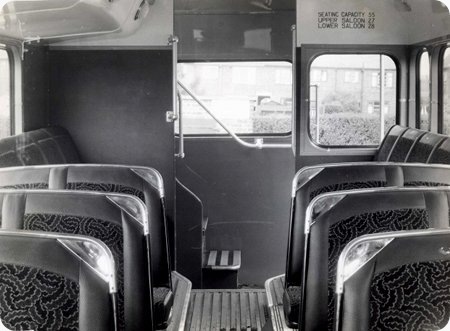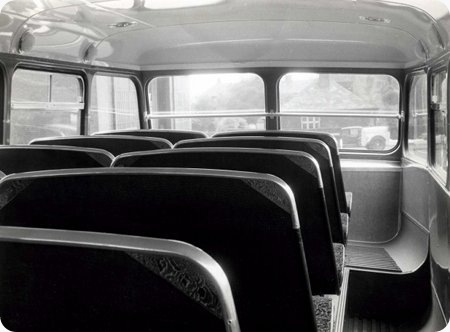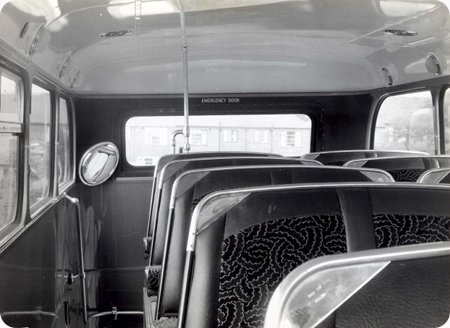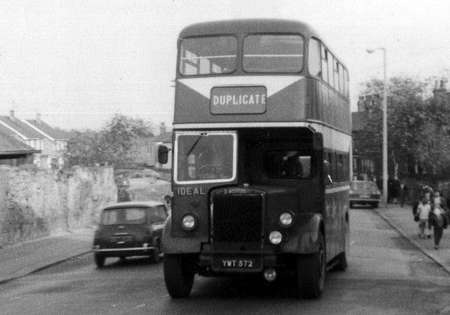Ideal Service – Leyland Titan PD2 – YWT 572
Ideal Service (R Taylor & Sons)
1959
Leyland Titan PD2 (on older Tiger PS1 chassis)
Roe L27/28R
My thanks to Robert Gomersall for these excellent internal shots of a newly delivered Roe bodied Titan to R Taylor & Sons of Cudworth near Barnsley who along with H Wray & Sons of Hoyle Mill operated under the name of Ideal Service. Roberts mother was the daughter of R H Taylor who took over operations from his father R Taylor who started the business. Robert would like to know when R Taylor actually started the business, if you know please leave a comment.
The lower deck is of a normal layout for a rear entrance double decker, but as this is a lowbridge vehicle it as a sunken gangway on the right hand side of the upper deck which can be seen quite clearly in the upper deck shot.
The seats as can be seen are just two normal two seat units put side by side, looking closely at the shot it looks as if the right hand pair is set back a little, probably to aid passengers getting past from the left hand seats. I am not sure if there was ever a one piece four seat unit, if you know please leave a comment. The sunken gangway can also be seen upper left in the 2nd lower deck shot and people sitting in the seats underneath it had to be careful when getting up as you could quite easily end up with a nasty bump on the head.
I think these shots are extremely good as there is a lot of people who will of never seen a lowbridge vehicle seating layout, thanks again Robert.
Photographs contributed by Robert Gomersall
Born and bred in lowbridge country, I imagined till the age of eight that a central aisle upstairs was for trolleybuses only. A family trip to London taught me otherwise, but I continue to defend the lowbridge design against all its critics: it survived in production for over forty years essentially to Leyland’s 1927 design. Reading Corporation’s two batches (1956-57) of Regent IIIs originally had 27 seats upstairs (six fours and a three) but were later upseated to 31 on top, with all the fours now staggered just as in the R. Taylor PD2. I think the main point was to discourage generously-upholstered mortals from claiming more than their allotted 17 inches of seat-width.
Last week I was (silently) grumbling that lowbridge Roe-bodied buses never turn up at Southern rallies, as I wanted to see the internal details, and here we have Robert G’s superb shots! A prayer answered.
Ian Thompson
These buses look unusually uncluttered and spacious, minus stanchions. As for bench seats in the upper saloons of lowbridge buses, London Transport inherited six ST’s with bodies by Short Bros. of Rochester. These had a sunken gangway EITHER side and bench seats for THREE. It also had the Godstone STL’s which had one sunken gangway, but seats in alternate rows of THREE and FOUR. I never travelled on them, and, although they had rounded tops to the seats, I don’t know whether they were bench seats or not. LT’s few lowbridge D’s (Daimler CWA6’s) had a sunken gangway with bench seats for FOUR. The first batch came with austerity wooden slatted seats, which would have caused some instability in passengers when going around corners. Even on similar double seats, one rode by the seat of one’s pants (so to speak) around corners, I recall!
Chris Hebbron
Another operator sadly missed! I was fortunate enough to travel on the Ideal Service in the early 70’s although by then it was being operated by H Wray alone. These photos are interesting because I hadn’t realised that a new double decker had been purchased as late as 1959. Logically it should still have been operating in 1970 although I don’t believe Wray took over any of Taylors vehicles when they decided to cease operating. I remember walking down to Hoyle Mill from Barnsley a few times to have a look at Wray’s operation and it was seemingly just an open yard with an inspection pit, I don’t recall seeing any covered accommodation! I think at the end, Wray had 3 or 4 double deckers, (perhaps always so) I remember travelling on a lowbridge AEC Regent V/Park Royal (ex Western Welsh?) an early Lodekka (ex W Yorks) and the last vehicle purchased, a Dennis Loline/Alexander, this giving the service a (fairly) modern image at last but unfortunately not for long! I’m not sure but I think that Wray, unlike Taylor, never purchased a new vehicle, and in the last few years tried to make sure their buses were from ‘red’ fleets to avoid the cost of re-painting! I’d love to know what became of YWT 572 because I’m sure there would have been plenty of miles left in it when Taylor sold up.
Chris Barker
What magnificent pictures these are and greatly appreciated. The vehicle is obviously assembled from the same Roe components as Samuel Ledgard’s six AEC Regent Mark Vs in 1957 – the panels, windows and frames, seats etc being identical. The only differences appear to be, obviously, the lowbridge layout and the rather luxurious light fittings. Good naturedly though, I must contest Ian’s praise of the lowbridge layout – while it undoubtedly solved the problem of height clearances such vehicles were very difficult for conductors, especially tall ones like me, and tended to roll alarmingly to the nearside if heavily laden and on badly cambered roads. By the way, West Yorkshire Road Car Co Ltd also experimented briefly in the 1950s with staggered upper saloon seating on lowbridge ECW Bristol KSWs.
Chris Youhill
I was fortunate enough, at the weekend, to combine a family gathering with a visit to the Sheffield Rally. In turn I was able to travel on STD 1156 (PD2/30) bodied by my beloved C H Roe. It was superb, albeit highbridge, but in every other respect, bar one, like these interior shots. [It has platform doors and an emergency door.]
The Leyland design was patented and could not originally be copied without buying a licence. Although, at that time, AEC did not have their own bodyworks, the blessed Mr Rackham had strong ideas about body design leading to certain stipulations for pre-war bodywork on AECs. Qs, therefore, like LTPB RTs after them, had very similar bodies regardless of Coachbuilder or operator. Likewise, Regents had the "Camel Hump" body for low-bridge operations. This was achieved by having gangways on both sides, three seats in a row and – conveniently – avoiding any infringement of the Leyland patent.
David Oldfield
Robert Taylor & Sons (Ideal Services) was taken over by the Yorkshire Traction. The Estate account shows Goodwill was £5700; Motor Vehicles £3025. Unfortunately it doesn’t itemise the vehicles sold.
Robert Gomersall
Just a couple of further points, a photograph of this vehicle in service appears on the Huddersfield Passenger Transport Group website, Buses in Barnsley section. It is not a PD2 but a re-bodied PS1. H Wray had one re-bodied in 1956 with a Roe body of Park Royal appearance which became KHE 528 and Taylor had this one done in 1959, both previously had Wilkes & Meade coach bodies. The earlier one was probably tagged on to a batch being done for Yorkshire Traction at the time. All of them were re-registered, maybe the Yorkshire Traffic Area was strict about such matters!
Apparently this vehicle passed to H Wray in 1967 so presumably this was the year that Taylor ceased operation.
Chris Barker
I read somewhere that the staggered upstairs seating was a standard ECW option towards the end of traditional lowbridge vehicles (mainly KSWs I think). It was said to improve access, but I would have thought the reverse – inside passengers having to jiggle round the S-bend as well as clambering over the knees of the outside passengers (or more likely asking them to move out).
Stephen Ford
03/08/11 – 15:57
Anyone know if the operators which made up Ideal Service were ever involved in a proposal to extend through to Pontefract the no. 70 Sheffield – Upton service? This would have been a more logical terminus and would have required one extra bus.
I worked for "Tracky" in the 70s and remember Ideal (by then , Wray only) running an ex-Bristol Omnibus Lodekka in the THW series. (However see above the comment about red fleets!)
Geoff Kerr
01/02/12 – 16:29
‘Yours’ Magazine Issue 133 (January 2012) has an interesting article written by a family member of Ideal Services (R H Taylor and Sons) complete with prints for those who are interested.
David Allen
02/02/12 – 09:10
Chris B, the re-registering of this fascinating vehicle is somewhat of a mystery as the Yorkshire Traffic Commissioners did not insist on the practice. I may be way out here, but I have a vague memory that if an operator wished to have a "prestigious" modern number the rebuilt vehicle had to have new chassis frames to be eligible, although the original number could be retained out of choice. Can anyone else remember such a ruling please ??
Chris Youhill
02/02/12 – 11:20
Chris Hebbron mentions how uncluttered the interior looks without stanchions and handrails. at Northern we were instructed not to allow standing passengers on coaches or DP’s because they didn’t have handrails, and if you look at the photo where the capacity is visible no mention is made of standing. Does anyone know if this was law or just Northern’s policy not to allow standing?
Ronnie Hoye
02/02/12 – 15:09
I believe Nottingham’s Roberts bodied AEC Regents had no stanchions. However the seats had a profiled back that was higher than these, and a grab-rail along the (straight) top which standees could hang on to. They allowed the usual maximum of 5 standing. I suspect that stanchions were not just for passenger convenience, but also provided a degree of bracing against bodyshell deformation. The Roberts bodies were of notoriously substantial build, and may not have needed this strengthening. I seem to remember that in the railway field the stanchions on the Class 150 DMUs figured in calculation of the bodyshell’s structural integrity.
Stephen Ford
02/02/12 – 17:23
I cannot remember stanchions in buses like this. I think you hung on to the seat back grab: perhaps there wasn’t room in a 7ft 6in body. You just walked "hand over hand" on the seat grabs down the aisle. Not only are the seats unusual, but finished in moquette: upstairs were often leather-type- I always thought because of ciggy burns and filthy overalls.
Joe
03/02/12 – 06:30
I’ve just noticed a most remarkable feature no doubt confined to the lowbridge version of this model of body. The lower saloon heater assembly is of greater width at the nearside to allow it to fit clear of the sunken gangway !!
Chris Youhill
03/02/12 – 10:33
Interesting observation, Joe. I can’t ever, down south, riding on any buses with leather/rexine seats upstairs (open-top and austerity ones excepted, of course). All were moquette. And London trams were the same. Yet there were plenty of dirty jobs in London. I suppose there were special floors ‘oop north’ta cater fer clogs, not to mention spittoons!!
Seriously, I will say that it was disgusting to go upstairs in buses in those days – a smog you could cut through and the smell and yellow/brown ceilings. Ugh! If I recall, on single-deck buses, the smokers were confined to the rear half of the bus. Smoking was endemic. I recall the clip of the ‘white horse’d’ policeman incident at Wembley in the twenties. A huge cloud of cigarette smoke rose from the crowd! Amazing.
Chris Hebbron
03/02/12 – 15:22
A bit off-topic, but following on from Chris H, I heard a tale of a certain paint shop foreman at Eastleigh railway works, who was given a new paint specification for Southern suburban trains, requiring white ceilings. Foreman was a bit of a curmudgeon, and said they’d had cream for years, and as far as he was concerned they would have cream until he retired. After a while Southern Region complained, and asked why they weren’t getting their white ceilings. Said curmudgeon was called before the production manager to explain himself. “There’s no point in painting the ceilings white,” he said. “After a fortnight they turn cream anyway with the cigarette smoke.” “So,” replied the production manager, “You, in your infinite wisdom, decided they should have built-in smoke!”
Stephen Ford
04/02/12 – 05:31
It is possible although not evident in the photographs that there could have been a handrail running horizontally along the lower deck at the top edge of the sunken gangway. It wasn’t just standees that needed something to hang on to, don’t forget the poor conductor too! Each time I look at the pictures, I can’t help but make a comparison with South Yorkshire’s TWY 8 which was re-bodied around the same time and had an identical shell but with platform doors and superior seats. Two notable firsts for me last year were travelling on it and meeting Chris Y on the same day!
Chris Barker
04/02/12 – 08:48
Lucky you, Chris B. I had the privilege of meeting Chris Y last year at Dunsfold – but the riding opportunities were very poor. Hope the return to Wisley improves that this year – but I gather there is no link with the (new) museum!
David Oldfield
29/03/12 – 08:23
In an earlier post Chris B mentioned that he thought that Wrays may not have had any covered accommodation at their site. I can recollect that from the late 1940’s until the 1960’s when I left Barnsley they had a garage on the left hand side at the bottom of Lord Street which could hold two vehicles side by side. Whether the roof was high enough to hold double deckers in the garage I am afraid I cannot remember but I think that it did. I think they also garaged their coal lorry there.
David Galley
29/03/12 – 17:54
Chris Hebbron jokingly refers to the use of spittoons on northern deckers. Interestingly many companies in the West Riding had notices on the upper deck forbidding spitting. Many of the Norths industries such as mining and textiles caused long term lung damage and TB was still an ever present in the thirties.
Chris Hough
16/01/13 – 13:44
Sorry to be a bit late with this contribution but I’ve only just found this website and what a great site it is. So many memories that I cant concentrate on work.
However, the interior views of YWT 572 were superb so my photo of the outside is a case of having a really bad camera (an Italian-made Bencini.) Italians are good at most things but cameras was not one of them.
This shot was taken in 1967 on an expedition with (I think) the late Jim Pass and Glyn Weigh from Oldham to Wakefield and was taken in South Elmsall (Emsull to the locals) on a trip that opened our eyes to the likes of South Yorkshire Motors, United Services and Ideal (Wray of Hoyle Mill and Taylor of Cudworth). I was told that YWT had a Lydney body but as it was built in 1959 as a rebody of a Leyland Tiger PS1, maybe it had a Lydney body in its first life but Lydney went out of business in the early 1950’s. I think YWT 572 under its previous guise had a Wilkes & Meade body but stand corrected if not.
Ian Lynas
16/01/13 – 14:47
Nice to see the outside of the bus. I would imagine that the white flash on the front was a belated and modest attempt at 1930’s streamlining!
Chris Hebbron
16/01/13 – 15:24
It’s got an interesting set of headlight/fog lights
Andrew Beever
16/01/13 – 16:36
Yes, I had one of those Bencini things, too Ian, a Comet S. In fact, as a collector of old cameras, I have one now, plus a couple of the bigger Koroll. I agree entirely with your assessment of them. They were mediocre both mechanically and optically. As for the array of head and foglights, this reminds us that fogs back in those days really were pea soupers.
Roger Cox
16/01/13 – 16:39
When Robert sent me the interior shots he also sent me a scan of a photocopy of a shot of YWT 572 when it was just leaving Roe, it wasn’t very good but with a touch of manipulation you can see the original headlight/foglight arrangement.
Peter
17/01/13 – 14:44
I see that Chris Barker has said above that he did not think that any of Taylor’s vehicles passed to Wray, but later stated that YWT 572 actually did. It is my own recollection that most of the Taylor vehicles did indeed pass to Wray (despite the fact that Taylor didn’t actually sell out to Wray, of course), and that Wray finished up with more ex-Taylor vehicles than the residue of their own existing stock. If, as is inferred above, the Taylor fleet initially passed with the business to Yorkshire Traction, the implication is that the vehicles were then passed on to Wray. The relationship between Ideal and Yorkshire Traction seems to have been easy-going, to say the least – on at least two occasions YTC vehicles passed to Ideal, which then proceeded to continue to run them in YTC colours.
The Huddersfield Passenger Transport Group website to which Chris refers actually has an entire page of photos of Ideal vehicles, and it can be found here www.jsh1949.co.uk/ The pics are of variable quality, however, and the one of YWT 572 is only average.
David Call
19/03/14 – 07:42
YWT 572 did indeed pass to Wrays along with tiger cub TWX963 both used by them TWX later passed Phipipson Goldthorpe for use on its Thurnscoe – Sheffield service
Garry
03/07/14 – 07:20
It would seem that the Ideal service from Barnsley to Pontefract began in 1923 and that in the early 1930s there were five operators in the partnership:-
Taylor of Cudworth, Wray of Hoyle Mill, Lancashire & Yorkshire Motors Ltd, Hartley and Wilson (these three based at Shafton).
Lancs & Yorks acquired the Hartley and Wilson shares and was itself taken over by Yorkshire Traction in 1934. I assume Tracky’s Shafton depot was inherited from them.
Geoff Kerr
04/11/14 – 06:37
I lived in Upton, near Pontefract from 1940-1985. I regularly travelled on the Ideal buses, either to Barnsley or to Pontefract. I recall one particularly snowy winters eve, probably 1958/59, when the bus was having a problem negotiating the steep hill out of South Elmsall. Passengers were asked if they would mind alighting and giving a helpful push to get the bus to the top. Several of us young men did so and the bus made it. At the top of the hill we got back on and continued our journey.
Albert Jones
25/11/17 – 08:14
I really love to see interior views of vehilces from this period. Interesting how the upperdeck lowbridge layout has pairs of doube seats rather than the four abreast single type. I like the "cable" pattern moquette as used by York Pullman
Tony J Griffin
15/01/19 – 06:52
I can remember back in the 1950s an outing that had 2 busses.
One was a low bridge type and the other a normal one.
Unfortunately, there was a low bridge about a mile down the road and the driver of the standard bus had forgotten that it wasn’t a low bus.
It pealed about 10ft of the roof off like a sardine can.
Fortunately, no one was injured.
David M
15/01/19 – 08:51
I’d like to add to a couple of points above, both coincidentally contained in Chris Barker’s posts. First of all the PS1 which was rebodied for Wray reappeared as KHE 526 rather than KHE 528.
Earlier Chris B had commented that he didn’t think that Wray had ever purchased a new vehicle. In fact ‘Bus Lists On The Web’ credits Wray as having had three vehicles new, only one fewer than Taylor. The three were:
AHE 110 Albion CX19/Pickering B34F, new 1945 (later to Carmichael of Glenboig)
AHE 987 Leyland Tiger PS1/Wilks & Meade C33F, new 1947 – this was the one later rebodied as KHE 526
DHE 40 Leyland Tiger PS1/Cawood B35F, new 1950
Note the correct spelling of Wilks & Meade.
Taylor’s ‘new’ vehicles are probably more memorable since they mostly dated from 1952-57 and therefore lasted well into the ‘enthusiast’ era.
David Call
16/01/19 – 07:23
Just a few additional thoughts. As Chris Hebbron commented, the white flash on the front of YWT572 was clearly a late addition, since it obviously wasn’t delivered like that. In fact, it is almost certainly a consequence of the arrival of CCK668, the ex-Ribble/Delaine Brush-bodied Leyland PD2, which also features on this site, and which didn’t come to Taylor’s until 1966. Do you think that the white flash was an attempt by Taylor’s to set their own vehicles apart from those of Wray’s? Certainly, there seems to be evidence that the relationship between Taylor’s and Wray’s wasn’t what it might have been. YWT572 and CCK668 may have been the only dds in use with Taylor’s at the time, since, unlike Wray’s, they did make significant use of saloons.
Because Bus Lists On The Web quotes Taylor’s as having received four vehicles new and Wray’s only three doesn’t mean that they were actually the only new vehicles, in fact I’m aware that both operators received new vehicles in the 1930s. An additional vehicle for Taylor’s is actually listed, but it’s credited to ‘Taylor’, rather than ‘Taylor, Cudworth’ so you wouldn’t find it unless you were to know what you were looking for.
Chris Y, I don’t think that the Traffic Commissioners had any say in whether or not a rebuilt vehicle received a new registration, it was down to the registration authority, and the latter did have varying standards.
The link I gave in 2013 to the ‘Ideal’ page on the HPTG website doesn’t now seem to work, so here’s a new one. www.jsh1949.co.uk/IDEAL
David M, are you prepared to say which operator was involved in the low bridge incident you mentioned? It clearly wasn’t Taylor’s or Wray’s, since neither operated highbridge vehicles.
David Call
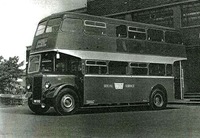 Vehicle reminder shot for this posting
Vehicle reminder shot for this posting
21/11/20 – 07:01
I have found H Wray jointly operating the 46 Pontefract – Barnsley service with Yorkshire Traction in the 1969 tracky timetable. You can see the joint timetable here – https://timetableworld.com/
Ken
Quick links to the - Comments Page - Contact Page - Home Page
Comments - Please note: The comments facility is not currently available. Please see the home page for updates.
Please Note if you want to send a photograph with your comment please use the Contact Page by clicking here or send as an attachment via email.

